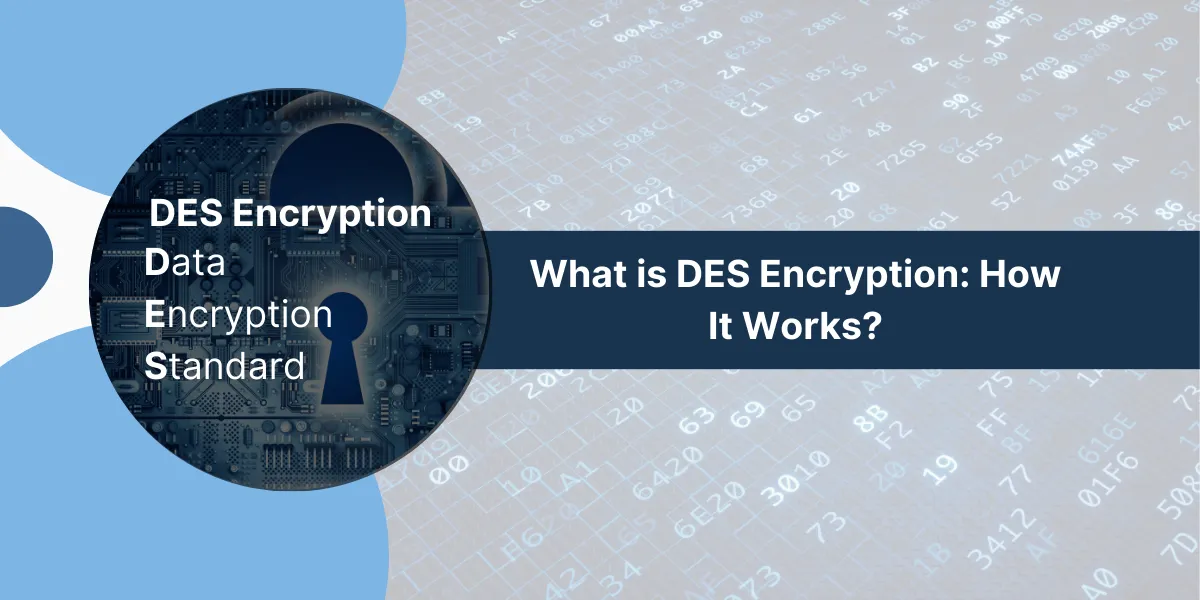A Basic Overview of Data Encryption Standard (DES)
DES (Data Encryption Standard) is a symmetric-key block cipher algorithm developed by IBM in the early 1970s. It was approved as a federal standard for data encryption in the United States in 1976 and remained prominent for over twenty years.
DES applies a 56-bit key to blocks of data 64 bits long and encrypts them into ciphertext blocks of 64 bits using 16 rounds of permutations, swapping, and substituting. DES was designed to be implemented easily in hardware and is overall fast and relatively secure.
Some key aspects of DES encryption include:
- Symmetric key algorithm: uses the same key for encryption and decryption
- Block cipher: operates on fixed-size blocks of plaintext
- 64-bit block size
- 56-bit key length
- 16 rounds of transformations
- Relies on substitution and permutation techniques
Although AES has replaced DES as the approved standard, it is still found in some legacy systems and provides the foundation for triple DES (3DES), which is still used in some applications.
This article will provide an in-depth look at how DES encryption works and the various components involved in the algorithm.
How DES Encryption Works
The DES encryption algorithm is quite complex, involving multiple rounds of substitutions, permutations, XOR operations, as well as shifts.
Here is an overview of the high-level steps:
- Key schedule: the 56-bit key is expanded into 16 scheduled subkey blocks.
- Initial permutation: rearranges the bits in the plaintext input block.
- 16 rounds of transformations
- Split the block into two 32-bit halves
- Apply round function on each half, which includes:
- Expansion
- XOR with subkey
- S-box substitutions
- Permutation
- Swap the two halves
- Inverse initial permutation: rearranges bits back to original positions
- Output 64-bit ciphertext block
Now let’s look at each of these steps in more detail.
Key Schedule
The 56-bit key is first passed through a permutation function and then split into two 28-bit halves. Each half is then treated separately and used to generate 16 subkeys: one for each round of the algorithm.
This key schedule involves left shifts and permutations to derive the subkeys from the initial key. The algorithm ensures that using related keys does not reveal patterns that could weaken the cipher.
Initial Permutation
This step rearranges the bits in the input 64-bit plaintext block according to a defined permutation. It ensures that duplicate plaintext blocks do not result in identical ciphertext blocks.
The initial permutation does not make use of the key and operates the same way for any input block.
Rounds Function
The core of the DES algorithm is the 16 rounds of transformations that are applied to the block. Let’s look at the steps in each round:
- The block is divided into two 32-bit halves
- The right half is expanded to 48 bits using an expansion permutation
- The expanded right half is XORed with the round subkey
- The result is split into 8 blocks of 6-bits each
- Each 6-bit block is passed through an S-Box substitution, which returns a 4-bit output
- The 32 bits output from the S-Boxes are permuted according to a fixed permutation
- The result of this permutation is XORed with the left half
- The left and right halves are swapped for the next round
After the 16th round, there is a final swap of the halves but no XOR with a subkey.
The expansion, XOR, S-Box, and permutation provide diffusion and confusion, which are key principles in cryptography. The swapping adds even more diffusion across the block.
Inverse Initial Permutation
The very last step is to apply the inverse of the initial permutation on the output of the last round. This inverse permutation undoes the reordering done by the initial permutation and produces the 64-bit ciphertext block.
Key Features of the DES Algorithm
Some key features and design choices within the DES algorithm include:
- Symmetric Cryptography: DES relies on a shared secret key between sender and receiver. The same key is used to encrypt and decrypt data, making key distribution easier compared to asymmetric cryptography.
- Block Cipher Mode: DES encrypts fixed-size blocks of 64 bits at a time. This mode supports parallelization and hardware optimization. Other modes, like CBC and CTR, can provide confidentiality and authenticity.
- 56-bit Key Length: The small key size of 56 bits was controversial even in the 1970s. Later, it enabled brute force attacks, which led to the need for 3DES.
- 16 Rounds: The designers of DES determined that 16 rounds provided an optimal balance between security and efficiency. This number effectively protects against cryptanalytic attacks.
- S-Box Substitutions: Eight nonlinear S-Box functions provide the confusion property desired in ciphers. The S-boxes randomize the input in a complex way.
- Permutations: Multiple permutations shuffle around the bits and provide diffusion across the block. This enhances security and hides patterns.
- Avalanche Effect: A small change in the plaintext results in significant changes to the ciphertext output. This is achieved through the rounds and XOR operations.
- Simplicity of Design: DES was designed to be easily implemented in hardware, which was useful when encryption hardware was expensive.
Although DES has some weaknesses by modern standards, it represents a milestone in the advancement of cryptography and lays the foundation for later ciphers.
Applications of DES Encryption
DES and 3DES have been utilized in a wide variety of applications, including:
- Encryption of government and military data
- Financial data security in the banking industry
- Encryption of nuclear test data
- Securing critical infrastructure
- File and disk encryption products
- ATM security
- Email and messaging encryption
- Digital signatures
- Password protection and verification
- PIN encryption and verification
Due to its small key size, DES is no longer recommended for most new systems and applications. AES has replaced it with highly sensitive data.
However, DES and 3DES still find some use today in legacy systems for low to moderate security needs. They may also be used where older hardware cannot support more advanced algorithms.
Breaking DES Encryption
There are a couple of approaches to breaking DES encryption:
Brute Force Attack
Due to the relatively small 56-bit key, DES is vulnerable to brute force attacks that try all possible keys. There have been several successful cryptanalysis efforts against DES that could find the key through brute force:
- In 1997, RSA Security sponsored a contest to crack DES. The winner was able to brute force a key in under 3 days.
- In 1998, the Electronic Frontier Foundation built a specialized DES cracking machine called Deep Crack that could brute force a DES key in less than a day.
- Costs and difficulty of brute forcing keys have dropped significantly as computing power has increased over time.
Cryptanalysis Attacks
More sophisticated cryptanalysis can potentially break DES faster than brute force:
- Linear cryptanalysis: Exploits imbalances in the S-Box outputs that can reveal information about the key bits.
- Differential cryptanalysis: Analyze how differences in input can lead to similarities in the production.
- Davies attack: Uses memory to optimize brute forcing combinations of key bits.
- Improved Davies Attack: Optimized attack that can break DES in an average of 10 hours.
Understanding these differences helps select the right cipher for particular use cases and requirements. Neither has a blanket advantage on security or performance.
What are the Strengths of DES Encryption
Despite having a short key length by today’s standards, DES does have some security strengths:
- Proven resilience against cryptanalysis over decades of scrutiny.
- Multiple rounds add complexity against attacks.
- Mixing substitution, permutation, and XOR makes analysis difficult.
- Encrypts data rapidly in hardware implementations.
- Output is well randomized – the avalanche effect in action.
- No theoretical cryptanalytic breaks are better than brute force.
DES can still provide adequate protection for moderately sensitive data, depending on the use case. The biggest risks come from brute force, which requires significant computing power.
- Wireless communications: Used historically in WEP and WPA security protocols to encrypt wireless traffic in a low latency manner.
- Hardware efficient environments: Better suited for encryption in constrained environments like embedded devices and IoT networks.
- Low error propagation: More resilient in noisy transmission environments where errors can’t be tolerated.
- High-throughput applications: Some stream ciphers provide very fast and simple encryption to keep up with high data volumes.
The split highlights how block ciphers are favored for storage, complex protocols, and randomness, while stream ciphers meet different performance and error resilience needs.
What are the Weaknesses of DES
The main weaknesses in DES encryption include:
- Small Key Size: 56-bits is no longer considered adequate. Vulnerable to brute force attacks.
- Encryption Mode: ECB mode has weaknesses including patterns revealing more information.
- Block Size: A 64-bit block is considered small. Larger blocks are harder to break.
- S-Box Design: Some flaws allow optimizations to brute forcing.
- No Authenticity: Encrypts data but does not authenticate the source.
- Hardcoded S-Boxes: Makes analysis easier compared to dynamic S-boxes.
While DES has held up relatively well, its age and design choices have yet to make it suitable for general use cases demanding high security.
What are the Alternatives to DES Encryption
Some common alternatives to DES include:
- AES: Advanced Encryption Standard uses 128-bit blocks and keys up to 256-bits. Very secure and widely adopted.
- Blowfish: Strong 64-bit block cipher using variable key length up to 448 bits. Compact and fast.
- Twofish: A 128-bit block cipher that allows keys up to 256 bits. Has a complex key schedule.
- Serpent: A 128-bit block cipher with keys up to 256-bits. Utilizes 32 rounds for security.
- 3DES: Applies DES three times with multiple keys. Increases key size to 168 bits.
- IDEA: Uses a 128-bit key on 64-bit blocks. Designed to be resistant to cryptanalysis.
Most applications today should use AES, 3DES, or another modern symmetric algorithm rather than DES. However, DES may still have niche applications in legacy systems.
Future of DES Encryption
DES has been deprecated and replaced by stronger algorithms like AES. It is only likely to persist in places where legacy systems and hardware cannot be easily upgraded.
Cryptographers do not recommend using DES for any application requiring high security. Brute force is too cheap, and the risks are too high.
That said, DES was an influential milestone in the history of cryptography. Aspects of its design informed the AES algorithm. DES proved that an iterating block cipher could be resilient against attacks for many years.
DES is now better seen as a learning tool and an artifact of 1970s cryptography. It will fade away over time as old systems are upgraded. The future belongs to algorithms like AES that offer larger keys and improved designs informed by decades of cryptanalysis on DES.
Final Thoughts
In summary, DES encryption is a widely-used symmetric-key algorithm that has been the standard for data encryption for decades. It works by taking a 64-bit plaintext block and a 56-bit key, and then applying a series of permutations, substitutions, and rounds to transform the plaintext into a 64-bit ciphertext.
While DES is no longer considered secure for many modern applications due to its relatively short key length, it remains an important part of cryptographic history and is still used in some legacy systems. Understanding how DES encryption works provides valuable insight into the fundamentals of symmetric-key cryptography.
Frequently Asked Questions About DES Encryption
Here are some common questions about the DES encryption algorithm:
What does DES stand for?
DES stands for Data Encryption Standard. The U.S. government adopted it as a federal standard for data encryption in 1976.
What is the key length for DES?
DES uses 56-bit keys. This small key length is one of its weaknesses compared to modern ciphers.
What is the block size in DES?
DES operates on blocks of 64-bits at a time. Each 64-bit block of plaintext encrypts to a 64-bit ciphertext output.
How many rounds are there in DES?
DES applies 16 rounds of transformations, including substitutions, permutations, and XOR operations.
Can DES be cracked through brute force?
Yes, DES is vulnerable to brute-force attacks that try every possible key. This is feasible due to the small 56-bit key length.
What are some alternatives to DES?
Better alternatives include AES, 3DES, Blowfish, Twofish, and other modern symmetric ciphers with larger keys and improved designs.
Is DES still used today?
DES usage today is limited to legacy systems and low: to moderate-security applications where AES cannot be deployed. It is no longer recommended for most uses.
What replaced DES as the encryption standard?
DES was replaced by AES (Advanced Encryption Standard) in 2001 after a 5-year public competition to select a new algorithm. The AES standard specifies 128-bit blocks and key sizes of 128, 192, and 256 bits.
Is DES secure enough for financial data?
No, DES should not be considered secure for highly sensitive financial data. Due to its small key size, it is vulnerable to brute-force attacks. AES is more appropriate for encrypting financial data.
Can DES be used for password hashing?
No, DES is not suitable for password hashing due to its fast speed and small key size. Password hashing requires slow algorithms with large outputs like BCrypt, PBKDF2, or SHA-3.

Priya Mervana
 Verified Web Security Experts
Verified Web Security Experts
Priya Mervana is working at SSLInsights.com as a web security expert with over 10 years of experience writing about encryption, SSL certificates, and online privacy. She aims to make complex security topics easily understandable for everyday internet users.



